Generative adversarial networks
Contents
# Install the necessary dependencies
import os
import sys
!{sys.executable} -m pip install --quiet pandas scikit-learn numpy matplotlib jupyterlab_myst ipython
31. Generative adversarial networks#
Generative adversarial networks (GANs) emerge as the virtuosos of artificial creativity, painting canvases with pixels rather than pigments. At their genesis, GANs were forged with a singular mission: to breathe life into the digital realm, conjuring new data from the ethereal depths of probability distributions. Their pioneering design was a symphony of innovation, orchestrating a duel between two neural networks in a ballet of creation and critique.
Picture this: on one side of the stage stands the Generator, a prodigious apprentice armed with brushes of binary. Its purpose, its raison d’être, is to craft masterpieces ex nihilo, stitching together pixels with mathematical finesse. With each iteration, it tiptoes closer to perfection, learning the intricate tapestry of the training set distribution like a virtuoso studying the score.
Opposing it, the Discerner awaits—the arbiter of authenticity, the gatekeeper of verisimilitude. Trained to discern the genuine from the counterfeit, it scrutinizes each creation with a discerning eye, sniffing out flaws and imperfections like a seasoned art critic.
The dance begins. With each pass, the Generator’s strokes grow bolder, its compositions more intricate, as it strives to outwit its adversary. Meanwhile, the Discerner stands vigilant, its discriminating gaze sharpened by every encounter. Back and forth they go, locked in an eternal tango of creation and critique.
And then, a breakthrough. In a moment of revelation, the Generator unveils a masterpiece—a synthesis of pixels so sublime, so lifelike, that even the Discerner is momentarily deceived. In that fleeting instant, the boundaries of possibility expand, as the digital canvas is imbued with the spark of innovation.
Such is the essence of GANs—a testament to the power of adversarial collaboration, where artistry and algorithm converge to redefine the boundaries of creativity. From images to text, from music to medicine, their domain knows no bounds, as they continue to shape the future of artificial intelligence, one pixel at a time.
GAN is proposed in 2005, the paper is Ian J. Goodfellow, Jean Pouget-Abadie, Mehdi Mirza, Bing Xu, David Warde-Farley, Sherjil Ozair, Aaron Courville, Yoshua Bengio. “Generative Adversarial Networks”, arxiv:1406.2661.
31.1. Code#
import tensorflow as tf
import requests
import numpy as np
import os
import matplotlib.pyplot as plt
import matplotlib.gridspec as gridspec
import warnings
warnings.filterwarnings("ignore")
%matplotlib inline
plt.rcParams['figure.figsize'] = (10.0, 8.0) # set default size of plots
plt.rcParams['image.interpolation'] = 'nearest'
plt.rcParams['image.cmap'] = 'gray'
31.1.1. Function of displaying a grid of images#
def show_images(images):
images = np.reshape(images, [images.shape[0], -1]) # images reshape to (batch_size, D)
sqrtn = int(np.ceil(np.sqrt(images.shape[0])))
sqrtimg = int(np.ceil(np.sqrt(images.shape[1])))
fig = plt.figure(figsize=(sqrtn, sqrtn))
gs = gridspec.GridSpec(sqrtn, sqrtn)
gs.update(wspace=0.05, hspace=0.05)
for i, img in enumerate(images):
ax = plt.subplot(gs[i])
plt.axis('off')
ax.set_xticklabels([])
ax.set_yticklabels([])
ax.set_aspect('equal')
plt.imshow(img.reshape([sqrtimg,sqrtimg]))
return
31.1.2. Functions of pre-processing and post-processing images#
def preprocess_img(x):
return 2 * x - 1.0
def deprocess_img(x):
return (x + 1.0) / 2.0
def rel_error(x,y):
return np.max(np.abs(x - y) / (np.maximum(1e-8, np.abs(x) + np.abs(y))))
def count_params(model):
"""Count the number of parameters in the current TensorFlow graph """
param_count = np.sum([np.prod(p.shape) for p in model.weights])
return param_count
31.1.3. Download a file from a URL using the requests library#
url = 'https://static-1300131294.cos.ap-shanghai.myqcloud.com/data/deep-learning/Gan/gan-checks-tf.npz'
response = requests.get(url)
with open('gan-checks-tf.npz', 'wb') as f:
f.write(response.content)
# Now you can use np.load on the downloaded file
answers = np.load('gan-checks-tf.npz')
NOISE_DIM = 96
31.1.4. Load Data#
class MNIST(object):
def __init__(self, batch_size, shuffle=False):
"""
Construct an iterator object over the MNIST data
Inputs:
- batch_size: Integer giving number of elements per minibatch
- shuffle: (optional) Boolean, whether to shuffle the data on each epoch
"""
train, _ = tf.keras.datasets.mnist.load_data()
X, y = train
X = X.astype(np.float32)/255
X = X.reshape((X.shape[0], -1))
self.X, self.y = X, y
self.batch_size, self.shuffle = batch_size, shuffle
def __iter__(self):
N, B = self.X.shape[0], self.batch_size
idxs = np.arange(N)
if self.shuffle:
np.random.shuffle(idxs)
return iter((self.X[i:i+B], self.y[i:i+B]) for i in range(0, N, B))
mnist = MNIST(batch_size=25)
show_images(mnist.X[:25])
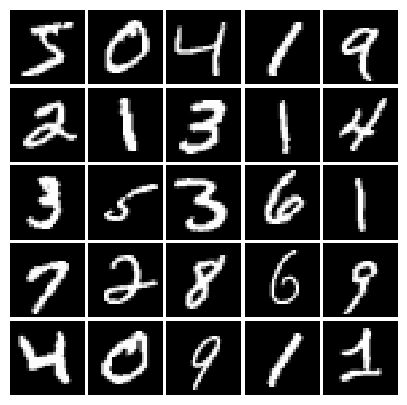
31.1.5. Compute the leaky ReLU activation function#
def leaky_relu(x, alpha=0.01):
x = tf.nn.leaky_relu(x,alpha)
return x
pass
31.1.6. Generate random uniform noise from -1 to 1#
def sample_noise(batch_size, dim):
noise = tf.random.uniform([batch_size,dim],minval = -1,maxval = 1)
return noise
pass
31.1.7. Compute discriminator score for a batch of input images#
def discriminator():
model = tf.keras.models.Sequential([
tf.keras.layers.InputLayer(784),
tf.keras.layers.Dense(256),
tf.keras.layers.LeakyReLU(0.01),
tf.keras.layers.Dense(256),
tf.keras.layers.LeakyReLU(0.01),
tf.keras.layers.Dense(1)
])
return model
warnings.filterwarnings("ignore")
def test_discriminator(true_count=267009):
model = discriminator()
cur_count = count_params(model)
if cur_count != true_count:
print('Incorrect number of parameters in discriminator. {0} instead of {1}. Check your achitecture.'.format(cur_count,true_count))
else:
print('Correct number of parameters in discriminator.')
test_discriminator()
Correct number of parameters in discriminator.
31.1.8. Compute generator score for a batch of input images#
def generator(noise_dim=NOISE_DIM):
model = tf.keras.models.Sequential([
tf.keras.layers.InputLayer(noise_dim),
tf.keras.layers.Dense(1024),
tf.keras.layers.ReLU(),
tf.keras.layers.Dense(1024),
tf.keras.layers.ReLU(),
tf.keras.layers.Dense(784,activation = tf.nn.tanh)
])
return model
def test_generator(true_count=1858320):
model = generator(4)
cur_count = count_params(model)
if cur_count != true_count:
print('Incorrect number of parameters in generator. {0} instead of {1}. Check your achitecture.'.format(cur_count,true_count))
else:
print('Correct number of parameters in generator.')
test_generator()
Correct number of parameters in generator.
31.1.9. Compute the discriminator loss#
def discriminator_loss(logits_real, logits_fake):
loss = None
cross_entropy = tf.keras.losses.BinaryCrossentropy(from_logits=True)
# *****START OF YOUR CODE (DO NOT DELETE/MODIFY THIS LINE)*****
real_loss = cross_entropy(tf.ones_like(logits_real), logits_real)
fake_loss = cross_entropy(tf.zeros_like(logits_fake), logits_fake)
loss = real_loss + fake_loss
# *****END OF YOUR CODE (DO NOT DELETE/MODIFY THIS LINE)*****
return loss
def test_discriminator_loss(logits_real, logits_fake, d_loss_true):
d_loss = discriminator_loss(tf.constant(logits_real),
tf.constant(logits_fake))
print("Maximum error in d_loss: %g"%rel_error(d_loss_true, d_loss))
test_discriminator_loss(answers['logits_real'], answers['logits_fake'],
answers['d_loss_true'])
Maximum error in d_loss: 6.02597e-17
31.1.10. Compute the generator loss#
def generator_loss(logits_fake):
loss = None
cross_entropy = tf.keras.losses.BinaryCrossentropy(from_logits=True)
# *****START OF YOUR CODE (DO NOT DELETE/MODIFY THIS LINE)*****
loss = cross_entropy(tf.ones_like(logits_fake), logits_fake)
# *****END OF YOUR CODE (DO NOT DELETE/MODIFY THIS LINE)*****
return loss
def test_generator_loss(logits_fake, g_loss_true):
g_loss = generator_loss(tf.constant(logits_fake))
print("Maximum error in g_loss: %g"%rel_error(g_loss_true, g_loss))
test_generator_loss(answers['logits_fake'], answers['g_loss_true'])
Maximum error in g_loss: 7.19722e-17
31.1.11. Create solvers for GAN training#
def get_solvers(learning_rate=1e-3, beta1=0.5):
D_solver = None
G_solver = None
D_solver = tf.optimizers.Adam(learning_rate,beta1)
G_solver = tf.optimizers.Adam(learning_rate,beta1)
pass
return D_solver, G_solver
31.1.12. Train a GAN for a certain number of epochs#
def run_a_gan(D, G, D_solver, G_solver, discriminator_loss, generator_loss,\
show_every=1000, print_every=20, batch_size=16, num_epochs=3, noise_size=96):
mnist = MNIST(batch_size=batch_size, shuffle=True)
iter_count = 0
for epoch in range(num_epochs):
for (x, _) in mnist:
with tf.GradientTape() as tape:
real_data = x
logits_real = D(preprocess_img(real_data))
g_fake_seed = sample_noise(batch_size, noise_size)
fake_images = G(g_fake_seed)
logits_fake = D(tf.reshape(fake_images, [batch_size, 784]))
d_total_error = discriminator_loss(logits_real, logits_fake)
d_gradients = tape.gradient(d_total_error, D.trainable_variables)
D_solver.apply_gradients(zip(d_gradients, D.trainable_variables))
with tf.GradientTape() as tape:
g_fake_seed = sample_noise(batch_size, noise_size)
fake_images = G(g_fake_seed)
gen_logits_fake = D(tf.reshape(fake_images, [batch_size, 784]))
g_error = generator_loss(gen_logits_fake)
g_gradients = tape.gradient(g_error, G.trainable_variables)
G_solver.apply_gradients(zip(g_gradients, G.trainable_variables))
if (iter_count % show_every == 0):
print('Epoch: {}, Iter: {}, D: {:.4}, G:{:.4}'.format(epoch, iter_count,d_total_error,g_error))
imgs_numpy = fake_images.cpu().numpy()
show_images(imgs_numpy[0:30])
plt.show()
iter_count += 1
# random noise fed into our generator
z = sample_noise(batch_size, noise_size)
# generated images
G_sample = G(z)
print('Final images')
show_images(G_sample[:16])
plt.show()
warnings.filterwarnings("ignore")
# Make the discriminator
D = discriminator()
# Make the generator
G = generator()
# Use the function you wrote earlier to get optimizers for the Discriminator and the Generator
D_solver, G_solver = get_solvers()
# Run it!
run_a_gan(D, G, D_solver, G_solver, discriminator_loss, generator_loss)
Epoch: 0, Iter: 0, D: 1.14, G:0.6946
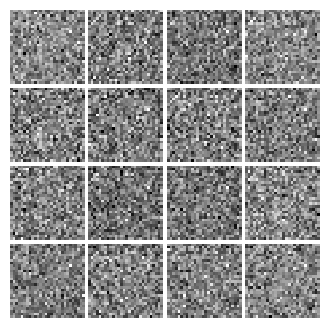
Epoch: 0, Iter: 1000, D: 0.7591, G:2.441
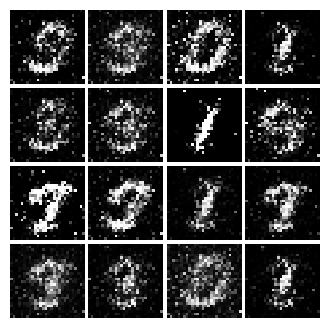
Epoch: 0, Iter: 2000, D: 0.9709, G:0.9196
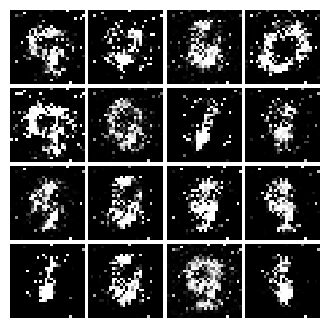
Epoch: 0, Iter: 3000, D: 1.2, G:2.018
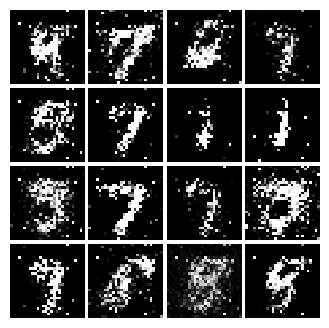
Epoch: 1, Iter: 4000, D: 1.199, G:1.177
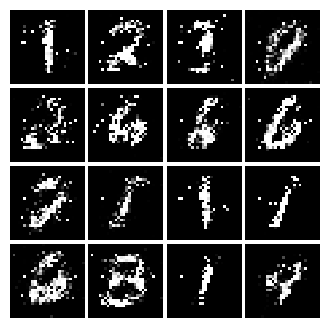
Epoch: 1, Iter: 5000, D: 1.263, G:1.492
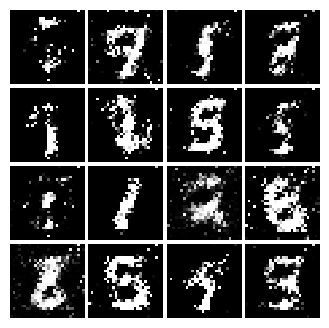
Epoch: 1, Iter: 6000, D: 1.287, G:0.8328
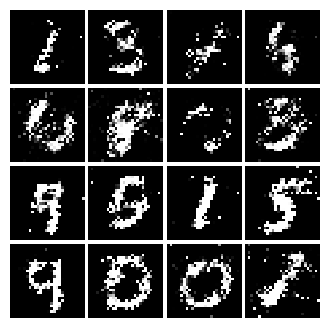
Epoch: 1, Iter: 7000, D: 1.295, G:1.124
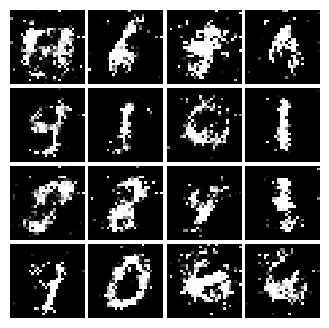
Epoch: 2, Iter: 8000, D: 1.302, G:1.125
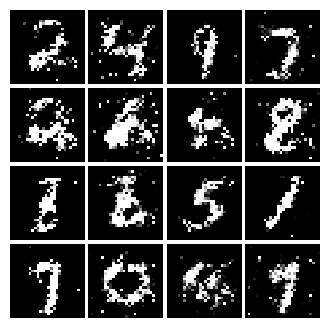
Epoch: 2, Iter: 9000, D: 1.118, G:0.6758

Epoch: 2, Iter: 10000, D: 1.173, G:0.7965
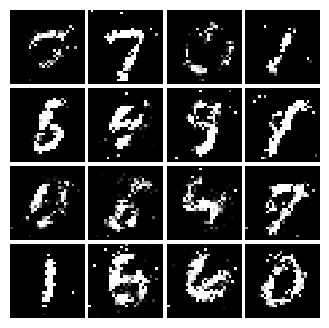
Epoch: 2, Iter: 11000, D: 1.351, G:0.9481
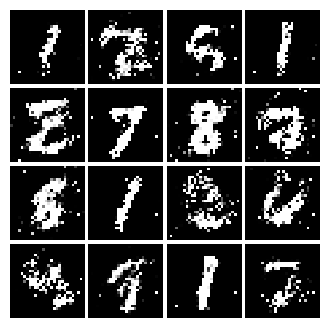
Final images
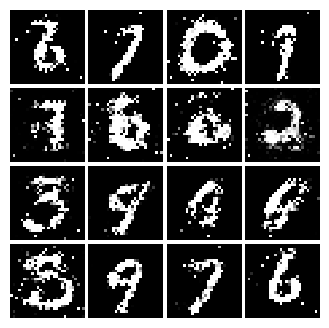
31.2. Your turn! 🚀#
Implement TODO part of the code in this notebook.
Assignment - Art by gan
31.3. Acknowledgments#
Thanks to Sebastian Raschka for creating the open-source project stat453-deep-learning-ss20 and Diego Gomez for creating the open-source project gans. They inspire the majority of the content in this chapter.


